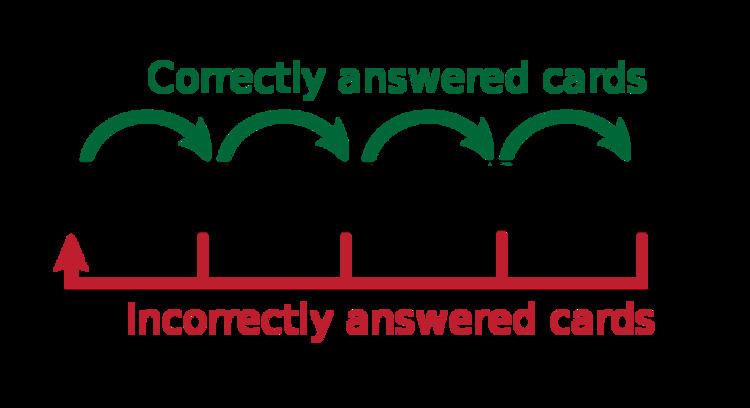 | ||
Spaced repetition is a learning technique that incorporates increasing intervals of time between subsequent review of previously learned material in order to exploit the psychological spacing effect. Alternative names include spaced rehearsal, expanding rehearsal, graduated intervals, repetition spacing, repetition scheduling, spaced retrieval and expanded retrieval.
Contents
Although the principle is useful in many contexts, spaced repetition is commonly applied in contexts in which a learner must acquire a large number of items and retain them indefinitely in memory. It is, therefore, well suited for the problem of vocabulary acquisition in the course of second language learning, due to the size of the target language's inventory of open-class words.
Research and applications
The notion that spaced repetition could be used for improving learning was first proposed in the book Psychology of Study by Prof. C. A. Mace in 1932: "Perhaps the most important discoveries are those which relate to the appropriate distribution of the periods of study...Acts of revision should be spaced in gradually increasing intervals, roughly intervals of one day, two days, four days, eight days, and so on."
In 1939, H. F. Spitzer tested the effects of a type of spaced repetition on sixth-grade students in Iowa learning science facts. Spitzer tested over 3600 students in Iowa and showed that spaced repetition was effective. This early work went unnoticed, and the field was relatively quiet until the late 1960s when cognitive psychologists, including Melton and Landauer & Bjork, explored manipulation of repetition timing as a means to improve recall. Around the same time, Pimsleur language courses pioneered the practical application of spaced repetition theory to language learning, and in 1973 Sebastian Leitner devised his "Leitner system", an all-purpose spaced repetition learning system based on flashcards.
With the increase in access to personal computers in the 1980s, spaced repetition began to be implemented with computer-assisted language learning software-based solutions, enabling automated scheduling and statistic gathering, scaling to thousands of cards scheduled individually. To enable the user to reach a target level of achievement (e.g. 90% of all material correctly recalled at any given time point), the software adjusts the repetition spacing interval. Material that is hard appears more often and material that is easy less often, with difficulty defined according to the ease with which the user is able to produce a correct response.
Algorithms
There are several families of algorithms for scheduling spaced repetition:
Some have theorized that the precise length of intervals does not have a great impact on algorithm effectiveness, although it has been suggested by others that the interval (expanded vs. fixed interval, etc.) is quite important. The experimental results regarding this point are mixed.
Pimsleur's graduated-interval recall
Graduated-interval recall is a type of spaced repetition published by Paul Pimsleur in 1967. It is used in the Pimsleur language learning system and is particularly suited to programmed audio instruction due to the very short times (measured in seconds or minutes) between the first few repetitions, as compared to other forms of spaced repetition which may not require such precise timings.
The intervals published in Pimsleur's paper were: 5 seconds, 25 seconds, 2 minutes, 10 minutes, 1 hour, 5 hours, 1 day, 5 days, 25 days, 4 months, and 2 years.
By timing a Pimsleur language program with a stopwatch, it is possible to verify that the intervals are not followed exactly but have upper and lower bounds. A similar principle (graduated intervals with upper and lower bounds) is used in at least one open source software project (Gradint) to schedule audio-only lessons.
Software
Most spaced repetition software (SRS) programs are modeled after the manual style of learning with flashcards: items to memorize are entered into the program as question-answer pairs. When a pair is due to be reviewed, the question is displayed on screen, and the user must attempt to answer. After answering, the user manually reveals the answer and then tells the program (subjectively) how difficult answering was. The program schedules pairs based on spaced repetition algorithms. Without a program, the user has to schedule flashcards; this is time-intensive and limits users to simple algorithms like the Leitner system.
Further refinements with regard to software:
Notable implementations include Anki, Brainscape, Cerego, Course Hero, Duolingo, Lingvist, Memrise, Mnemosyne, Skritter, SuperMemo, Synap and WaniKani.
